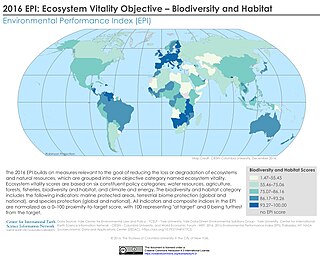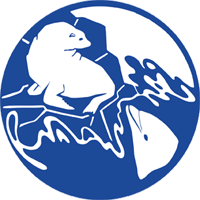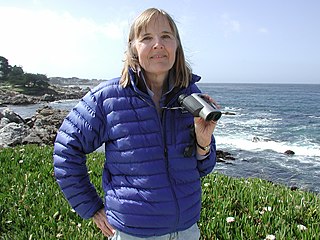Related Research Articles

Conservation biology is the study of the conservation of nature and of Earth's biodiversity with the aim of protecting species, their habitats, and ecosystems from excessive rates of extinction and the erosion of biotic interactions. It is an interdisciplinary subject drawing on natural and social sciences, and the practice of natural resource management.

In zoology, mammalogy is the study of mammals – a class of vertebrates with characteristics such as homeothermic metabolism, fur, four-chambered hearts, and complex nervous systems. Mammalogy has also been known as "mastology", "theriology", and "therology". The archive of number of mammals on earth is constantly growing, but is currently set at 6,495 different mammal species including recently extinct. There are 5,416 living mammals identified on earth and roughly 1,251 have been newly discovered since 2006. The major branches of mammalogy include natural history, taxonomy and systematics, anatomy and physiology, ethology, ecology, and management and control. The approximate salary of a mammalogist varies from $20,000 to $60,000 a year, depending on their experience. Mammalogists are typically involved in activities such as conducting research, managing personnel, and writing proposals.

The European water vole or northern water vole, is a semi-aquatic rodent. It is often informally called the water rat, though it only superficially resembles a true rat. Water voles have rounder noses than rats, deep brown fur, chubby faces and short fuzzy ears; unlike rats their tails, paws and ears are covered with hair.

The European hedgehog, also known as the West European hedgehog or common hedgehog, is a hedgehog species native to Europe from Iberia and Italy northwards into Scandinavia and westwards into the British Isles. It is a generally common and widely distributed species that can survive across a wide range of habitat types. It is a well-known species, and a favourite in European gardens, both for its endearing appearance and its preference for eating a range of garden pests. While populations are currently stable across much of its range, it is declining severely in Great Britain where it is now Red Listed, meaning that it is considered to be at risk of local extinction. Outside its native range, the species was introduced to New Zealand during the late nineteenth and early twentieth centuries.
David Whyte MacdonaldCBE FRSE is a Scottish zoologist and conservationist. He is the Director of the Wildlife Conservation Research Unit (WildCRU) at the University of Oxford, which he founded in 1986. He holds a Senior Research Fellowship at Lady Margaret Hall with the Title of Distinction of Professor of Wildlife Conservation. He has been an active wildlife conservationist since graduating from Oxford.

Foster's rule, also known as the island rule or the island effect, is an ecogeographical rule in evolutionary biology stating that members of a species get smaller or bigger depending on the resources available in the environment. For example, it is known that pygmy mammoths evolved from normal mammoths on small islands. Similar evolutionary paths have been observed in elephants, hippopotamuses, boas, sloths, deer and humans. It is part of the more general phenomenon of island syndrome which describes the differences in morphology, ecology, physiology and behaviour of insular species compared to their continental counterparts.

Aldo Starker Leopold was an American author, forester, zoologist and conservationist. Leopold served as a professor at the University of California, Berkeley, for thirty years within the Zoology, Conservation, and Forestry departments. Throughout his life, Leopold was a public face for science. He was active in numerous wildlife and conservation groups and made significant research contributions in ornithology, mammalogy, and wildlife ecology. Leopold is notable for his ecosystem management paper, the Leopold Report, and his considerable presence in some of the most controversial wildlife issues, including national park wildlife policy, predator control, wildlife refuge, and fire policy.

Dame Georgina Mary Mace, was a British ecologist and conservation scientist. She was Professor of Biodiversity and Ecosystems at University College London, and previously Professor of Conservation Science and Director of the Natural Environment Research Council (NERC) Centre for Population Biology, Imperial College London (2006–2012) and Director of Science at the Zoological Society of London (2000–2006).
A Regional Red List is a report of the threatened status of species within a certain country or region. It is based on the IUCN Red List of Threatened Species, an inventory of the conservation status of species on a global scale. Regional Red Lists assess the risk of extinction to species within a political management unit and therefore may feed directly into national and regional planning. This project is coordinated by the Zoological Society of London, the World Conservation Union (IUCN) and partners in national governments, universities and organizations throughout the world.

The Saiga Conservation AllianceSCA is a network of researchers and conservationists working to study and protect the critically endangered Saiga Antelope and their habitat. The Saiga are often seen as a major flagship species of the Central Asian and pre-Caspian steppes. In the last ten years, saiga populations have declined by 96%, which is the fastest decline ever recorded for a mammal species. Saiga Conservation Alliance is partnered with the Wildlife Conservation Network.

The Society for Marine Mammalogy was founded in 1981 and is the largest international association of marine mammal scientists in the world.

The Burrunan dolphin is a proposed species of bottlenose dolphin found in parts of Victoria, Australia first described in 2011. Its exact taxonomy is debated: numerous studies support it as being a separate species within the genus Tursiops and occupying a basal position within the genus, with limited phylogenetic studies using different methodologies indicate that it is a subspecies of the Indo-Pacific bottlenose dolphin. The Burrunan dolphin is not currently recognized as a species by the Society for Marine Mammalogy or American Society of Mammalogists, which cites problematic methodology in the original study proposing species status and recommends further research.

Katherine S. Ralls is an American zoologist and conservationist who is Senior Research Zoologist Emerita at the Smithsonian Conservation Biology Institute, National Zoological Park. Ralls' research interests are in the behavioral ecology, genetics, and conservation of mammals, both terrestrial and marine. Since 1980, she has focused on conservation biology, especially the genetic problems of small captive and wild populations.

Peoples Trust for Endangered Species (PTES) is a charitable organisation registered in England and Wales. It exists to promote the conservation of rare or declining species and habitats in the UK and worldwide through monitoring, public engagement, education, and through the funding of conservation projects and research. It also owns and manages two nature reserves. As of April 2015, PTES has 16 employees, five trustees and coordinates around 24,000 volunteers in the UK. PTES relies on donations from the general public and grants from trusts and foundations to continue its work - it receives no core funding from the UK Government. The organisation has registered charity number 274206.
Don Ellis Wilson is an American zoologist. His main research field is mammalogy, especially the group of bats which he studied in 65 countries around the world.

Rodrigo A. Medellín is a Mexican ecologist and Senior Professor of Ecology at the Institute of Ecology, University of Mexico (UNAM). Known for his work in bat, jaguar, bighorn sheep and other species conservation, his research has always been designed and conducted to advice conservation policy and conservation decision-making processes in Mexico and 16 other countries for over 40 years.
Franklyn Hugh Perring PhD, OBE was a British naturalist, regarded as "one of the most influential botanists and nature conservationists of the 20th century".
Kit Kovacs is a marine mammal researcher, best known for her work on biology, conservation and management of whales and seals. She is based at the Norwegian Polar Institute (NPI), Tromsø and is an adjunct professor of biology, marine biology, at the University Centre in Svalbard (UNIS).
Lim Boo Liat was a Malaysian zoologist whose pioneering work revealed the biological diversity of the Malay Peninsula and Borneo. He was a conservationist and a strong advocate for the preservation of the region's natural heritage.
Oscar de Beaux was an Italian mammalogist. His studies of mammals primarily concerned the Italian colonies of Africa. De Beaux was also a conservationist, authoring one of the first papers to argue the ethics of conservation, "Biological ethics: an attempt to arouse a naturalistic conscience".
References
- ↑ "UK BAP Mammals: Interim Guidance for Survey Methodologies, Impact Assessment and Mitigation". www.nhbs.com.
- ↑ "handbook". Archived 2013-07-01 at the Wayback Machine